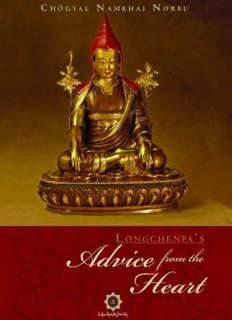
Longchenpa's Advice from the Heart PDF
Preview Longchenpa's Advice from the Heart
Longchenpa’s Advice from the Heart © 2008 Shang Shung Institute Località Podere Nuovissimo 58031 Arcidosso (GR) Italy www.shangshungpublications.org [email protected] Cover design by Daniel Zegunis Cover photo by Yeshi Silvano Namkhai ISBN 978-88-7834-114-2 IPC—534EN08 Approved by the International Publications Committee of the Dzogchen Community founded by Chögyal Namkhai Norbu Chögyal Namkhai Norbu Longchenpa’s Advice from the Heart Transcribed and edited by Elio Guarisco Contents Foreword Introduction The Knowledge of Dzogchen— Base, Path and Fruit The Base—Essence The Base—Nature The Base—Energy The Importance of Transmission Symbolic Transmission Oral Transmission Direct Transmission Devotion and Knowledge Grounded in Experience Anuyoga—Instantaneous Transformation The Path: the Essence of the Practice The Importance of Guruyoga Guruyoga in Dzogchen The Conduct of a Practitioner Being Present Ordinary Presence and Instant Presence The Ultimate Purification The Awareness of Circumstances Direct Introduction to our Real Nature Thirty Words of Advice from the Heart Original Text Commentary Homage to the Master The Exhortation The First Word of Advice The Second Word of Advice The Third Word of Advice The Fourth Word of Advice The Fifth Word of Advice The Sixth Word of Advice The Seventh Word of Advice The Eighth Word of Advice The Ninth Word of Advice The Tenth Word of Advice The Eleventh Word of Advice The Twelfth Word of Advice The Thirteenth Word of Advice The Fourteenth Word of Advice The Fifteenth Word of Advice The Sixteenth Word of Advice The Seventeenth Word of Advice The Eighteenth Word of Advice The Nineteenth Word of Advice The Twentieth Word of Advice The Twenty-first Word of Advice The Twenty-second Word of Advice The Twenty-third Word of Advice The Twenty-fourth Word of Advice The Twenty-fifth Word of Advice The Twenty-sixth Word of Advice The Twenty-seventh Word of Advice The Twenty-eighth Word of Advice The Twenty-ninth Word of Advice The Thirtieth Word of Advice Concluding Advice How to Integrate the Practice in Daily Life Foreword This book contains a new translation of Longchenpa’s Thirty Words of Advice from the Heart (sNying gtam sun bcu pa) and the edited transcription of the commentary given by Chögyal Namkhai Norbu during the retreat that took place from November 25th to 29th, 2007 in Barcelona, Spain. I translated Longchenpa’s text from Tibetan using two different editions of the original work: one contained in the collected writings of Longchenpa, the other published by Ogyan Kunsang Chökorling, Darjeeling, India. Longchenpa Trime Öser (1308-1363) was one of the most important Dzogchen masters of Tibet. He is to the Nyingma school what Tsongkhapa is for the Gelug, Sakya Pandita to the Sakya and Marpa Chökyi Lodrö to the Kagyü. His beautiful and inspired words of advice were probably written when Longchenpa was still a young man engaged in his studies. This master’s scriptural learning and realization were equal to those of the famous saints who graced the land of India, and true to his words of advice, his was a disciplined life spent in forest and mountain hermitages. Longchenpa’s Thirty Words of Advice are like nuggets of gold offered to us in his open hand, so that their inspiration can turn our mind to a sincere and uncorrupted spiritual practice. With his clear introduction to the principles and practice of Dzogchen, Chögyal Namkhai Norbu sets in context the thirty words of advice and then proceeds to explain each one as the basis of Longchenpa’s spiritual experience, in a way that is relevant to us as individuals in our time. I wish to thank Adriano Clemente and Maurizio Mingotti for their substantial contributions in editing and annotating the final version of the manuscript, and Nancy Simmons for thoroughly revising the English of the entire book. Elio Guarisco Introduction The Knowledge of Dzogchen: Base, Path and Fruit Dzogchen contains a very important and comprehensive knowledge of the Base, Path and Fruit.[1] ‘Base’ refers to the principle of our real condition. ‘Path’ refers to the way in which we can obtain the realization of that condition. ‘Fruit’ is the final result of the practice. These three points are shared by all kinds of teachings, not only those of Dzogchen. However, the understanding of what the Base is differs completely in Sutra, Tantra and Dzogchen.[2] For this reason, the practice and the idea of what realization is are different. What is the Base? In Dzogchen the condition of the base is presented as three primordial wisdoms.[3] Although our real nature cannot be fully explained in words, we need to have a general idea, so that through these wisdoms, we can describe at least in an approximate way what our real nature is. ‘Three primordial wisdoms’ does not mean that these three are separate. However, for didactic purposes we can understand primordial wisdom through its three different aspects: Essence, Nature and Energy.[4] The Base—Essence Essence is emptiness, the real nature of all things. The sutras also speak of this principle. The Mahayana sutras, in particular, emphasize to a great extent emptiness or Shunyata.[5] In this regard, the well known Buddhist term Dharmadhatu, in which dharma refers to all things, all existence, and dhatu to the real nature, simply means emptiness. Emptiness is the base: it is like space, in which all things can manifest and exist. All sentient beings and their sensory fields exist in and by that space. The Essence is also explained as the Dharmakaya.[6] Kaya means dimension, in this case the real dimension of all things, which is emptiness—the Dharmadhatu. Here, we must distinguish the term Dharmadhatu from its twin term, Dharmata. We have two different terms because Dharmadhatu is the real nature of all things and beings, all phenomena, while Dharmata represents the ultimate condition of sentient beings only. If we speak of the real condition of a table, for example, we do not say Dharmata but Dharmadhatu.
Description: